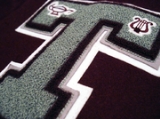
Varsity letter
Encyclopedia

United States
The United States of America is a federal constitutional republic comprising fifty states and a federal district...
for excellence in school activities. A varsity letter signifies that its winner was a qualified varsity team
Varsity team
In the United States and Canada, varsity sports teams are the principal athletic teams representing a college, university, high school or other secondary school. Such teams compete against the principal athletic teams at other colleges/universities, or in the case of secondary schools, against...
member, awarded after a certain standard was met.
Description
The award letter is usually made in the colors and initials representing the school that the recipient attends. The letter patch is primarily constructed of chenille and feltFelt
Felt is a non-woven cloth that is produced by matting, condensing and pressing woollen fibres. While some types of felt are very soft, some are tough enough to form construction materials. Felt can be of any colour, and made into any shape or size....
materials. Standard sizes range from 4 inches (10 cm) to 8 inches (20 cm). While 4 inches (10 cm) and 5 inches (13 cm) usually denote Junior Varsity achievements, 6 inches (15 cm) to 8 inches (20 cm) would denote plain (Senior) Varsity. The stitching style used for creating the chenille look is called a moss stitch, while the outlining sew down is called a chain stitch. The letters are made by both hand and automated machine depending on the company manufacturing the emblem. It is a wide spread commonality that the chenille made on hand machines produce a finer and tighter knap as compared to the automated machines. Automated machines tend to leave the chenille looking like a grid and are used in low quality emblems.
History
It seems with the advent of organized sports, there was a need for uniforms. There was an additional need for identifications which was satisfied by the use of emblems or letters.In 1865, the Harvard
Harvard University
Harvard University is a private Ivy League university located in Cambridge, Massachusetts, United States, established in 1636 by the Massachusetts legislature. Harvard is the oldest institution of higher learning in the United States and the first corporation chartered in the country...
baseball team added an Old English 'H'. The 'H' was embroidered on the gray flannel shirt. The football team started to use the 'H' in 1875. It is interesting to note that for 25 years following the introduction in 1865 of the letter, it was the practice for the team captain to allow certain players who played in the most important games (Yale or Princeton) to keep the 'H' jerseys as an award. If a player did not play in an important game, the player had to return the jersey at the end of the season. Awarding the 'H' jersey may have been the birth of the varsity letter as an award. The letterman sweater was first regularly used by the 1891 "Nine" (baseball) and was black with a small Crimson 'H' on the left breast.
It is not known when the letter sweater came to high schools. The earliest example that VLAS has come across is in the 1911 yearbook of Phoenix Union High School, Arizona Territory. Pictured, not in football uniform, wearing a V-net sweater with the letter 'P' on the left side, is a student in a group photo.
The sweater seems to home for the award letter from the 1890s until the 1930s. Another award during the 20s and 30s was a stadium style blanket given as an award.
In the 1930s, the letter award started to appear on leather sleeved, wool-bodied jackets. The jackets from the 30s were different in design than today's modern jacket.
Variations and application
As a decorative clothing item, the varsity letter has a huge number of variations and no set standard is made to any school on how it should look.Chenille letters come in many different forms and shapes. Some institutions use Old English or script style, two or three letter monogram, 3D shading, chenille bordered or the traditional straight block style. Students generally receive only one actual letter, but can win the distinction multiple times. These additional designations are shown by adding embroidered sport insignias, modeled metal insert pins, or bars that are attached to the letter. Some schools may embroider non-athletic letters with their award title, such as "Academics" or "Arts”.
The chenille letter is traditionally placed on the left chest of the varsity jacket, which is also at times adorned with championship chenille patches showcasing the team or individual accomplishments. School mascot patches are also commonly used.
In the last several years, Varsity Jackets have been adopted into the Hip Hop style of dress with companies such as Avirex
Avirex
Avirex was originally founded by Jeff Clyman in 1975 as a brand for military apparel. Contrary to popular belief, Avirex was not a U.S. military supplier during World War II...
, Phat Farm
Phat Farm
Phat Farm is a national fashion line created by the vision of Russell Simmons, the founder of the modern day hip-hop movement, Phat Farm, a division of Phat Fashions , is symbol of men's contemporary American culture, mixing the urban aesthetics of the streets and the preppy culture of the Ivy...
and Rocawear
Rocawear
Created in 1999 by Roc-A-Fella Records co-founders Damon Dash and Jay Z,Rocawear has annual sales of $700 million. Rocawear expanded its brand through licensing pacts to develop lines for children and juniors; socks and sandals; leather, suede, and fur outerwear; handbags and belts; lounge wear;...
making their own variations.

